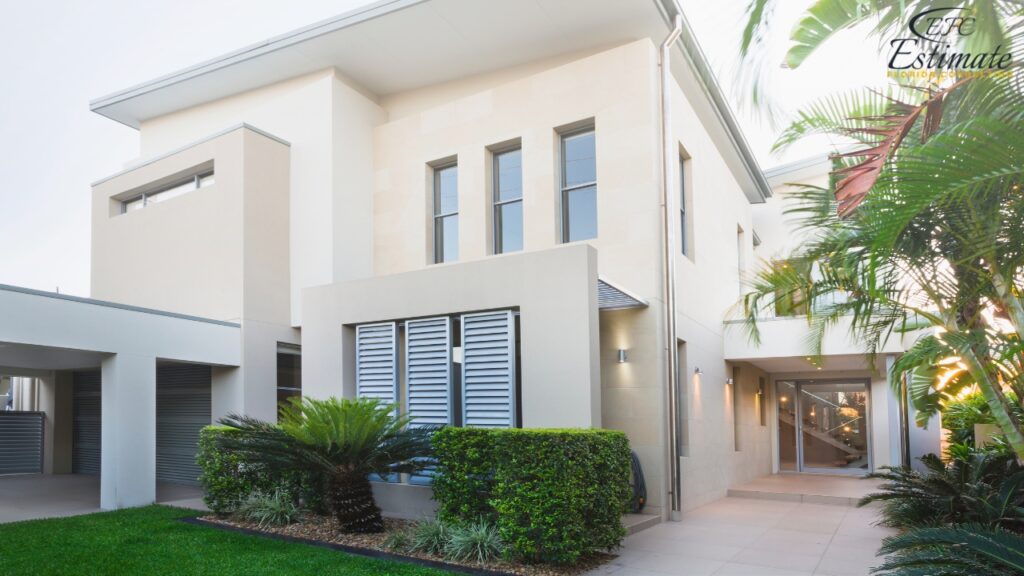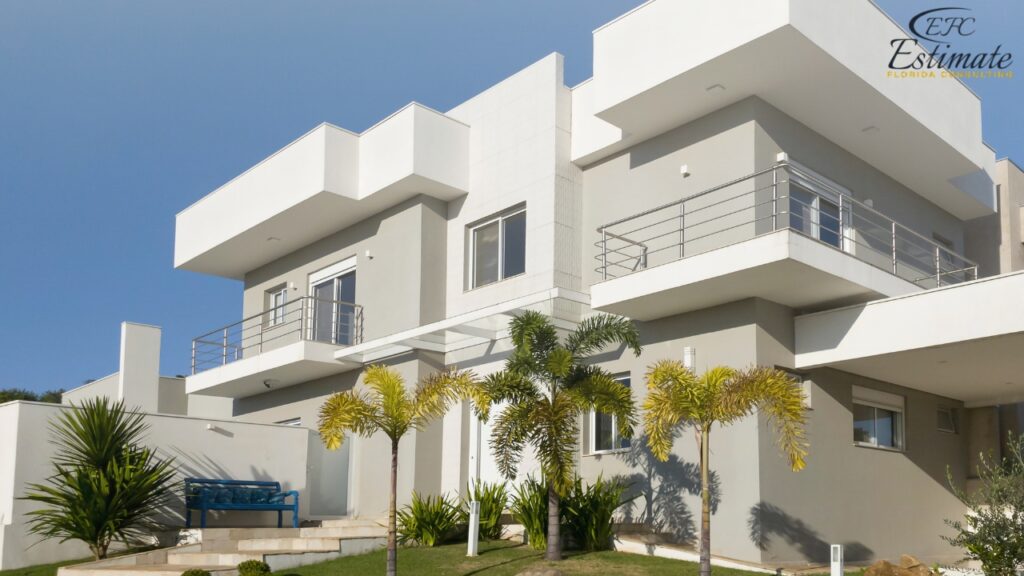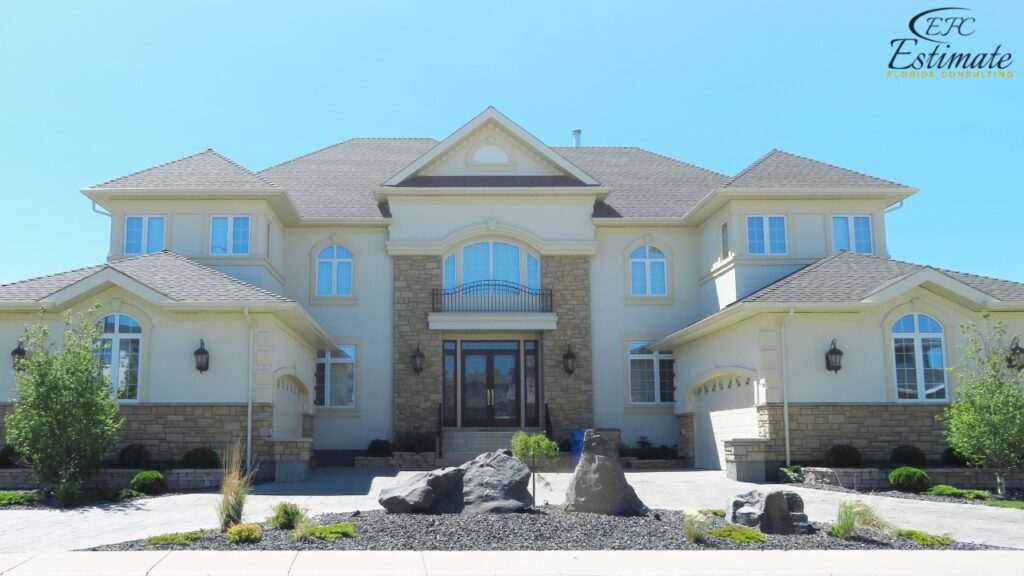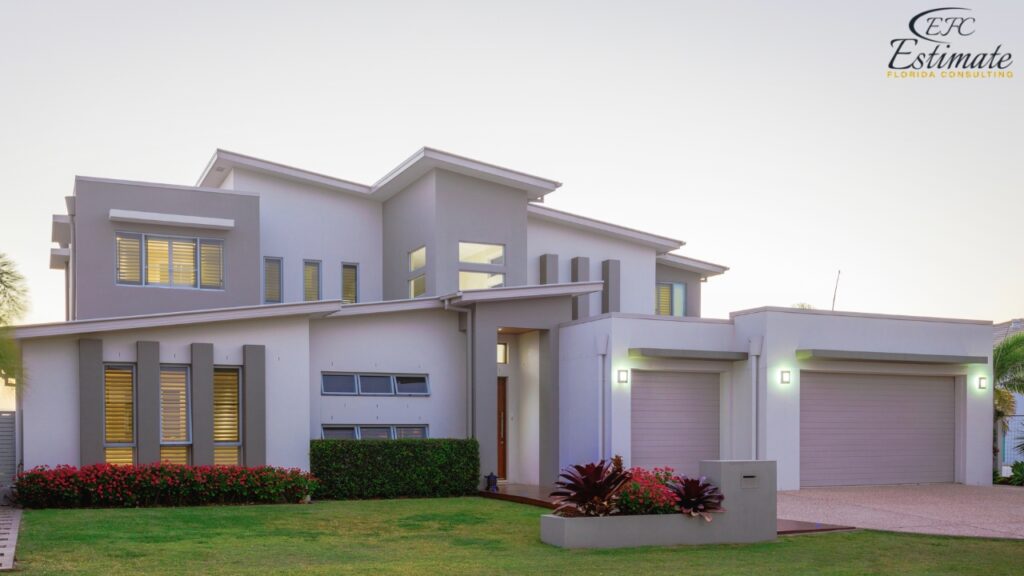How Much Exterior Paint a 1,500 sq ft House?
Painting the exterior of a 1,500 sq ft house typically costs between $3,375 and $9,000. The price varies depending on the size of the area, averaging $2.25 to $6 per square foot.
Larger homes, or those with multiple stories or hard-to-reach areas, tend to have higher costs. For instance, painting a two-story home generally costs between $4,500 and $9,300, while a three-story home can range from $6,750 to over $15,000.

Factors Affecting Exterior House Painting Costs
Exterior house painting costs depend on a variety of factors, including the size and shape of the house, the type and quality of paint used, labor costs, necessary repairs before painting, and more. Understanding these factors can help you plan and budget more effectively for your painting project.
Size and Shape of the House
The size and shape of the house are generally the most significant factors in determining painting costs. Larger homes require more materials and time, especially if they have longer or higher walls. Homes with intricate architectural details, such as gables, dormers, or elaborate trim, may need additional prep time or specialized paints, which can further increase costs. For example, a multi-story home or a house with a complex roofline will likely be more expensive to paint due to the increased difficulty and time required.
Type of Paint
The type of paint chosen also impacts the cost of exterior house painting. Higher-quality paints tend to last longer and offer better protection against the elements, but they cost more upfront. These paints often have better coverage, meaning fewer coats are needed, which can save on labor costs. Specialty paints, such as those for trim or accents, which offer extra durability and protection from UV rays, moisture, and mildew, can be more expensive. Some eco-friendly or low-VOC (volatile organic compounds) paints, which are better for the environment and indoor air quality, may also come at a premium price.
Labor Costs
Labor costs are another major factor. Professional painters typically charge a flat rate plus an hourly fee for labor. These rates can vary based on the painter’s experience, the region, and the complexity of the job. For instance, painting a home with multiple stories, difficult access areas, or extensive prep work can significantly increase labor costs. Additionally, painters may charge more for tasks such as removing old paint, sanding rough areas, or applying primer. It’s also worth noting that peak seasons, like summer, may see higher labor rates due to increased demand.
Repairs
Any necessary repairs before painting will add to the total cost. This could include tasks such as:
- Replacing rotten wood
- Patching holes
- Fixing cracks in the walls
- Addressing mold or mildew issues
- Repairing or replacing damaged siding
The cost of these repairs depends on their extent. Minor repairs might be relatively inexpensive, while extensive structural repairs can significantly increase the project’s overall cost. It’s best to consult with a professional painter or contractor to get an accurate estimate before beginning the work.

Additional Considerations
Several other factors can influence the cost of exterior house painting:
- Surface Preparation: Proper preparation is crucial for a long-lasting paint job. This includes cleaning the surface, removing dirt, mildew, and loose paint, and priming. Pressure washing the exterior can also add to the cost but is often necessary for proper adhesion of the new paint.
- Geographical Location: Costs can vary significantly based on your location. Areas with higher costs of living or those prone to harsh weather conditions may see higher painting costs.
- Weather Conditions: Painting during optimal weather conditions can affect the price and quality of the job. Extreme temperatures or high humidity can hinder the painting process, potentially leading to higher costs or delays.
- Warranty and Insurance: Hiring a licensed and insured painter may cost more upfront, but it provides peace of mind and protection against potential issues. Many professional painters offer warranties on their work, which can be an important factor to consider.
Cost to Paint House Exterior by Number of Stories
The number of stories in a house significantly affects the cost of painting its exterior. This is due to the increased surface area and higher labor costs associated with taller structures. Accessibility and safety concerns arise when painters need to use taller ladders or scaffolding, requiring more time and effort to complete the job on multi-story homes.
Average Exterior Painting Cost by Number of Stories
The table below outlines the average total cost to paint a home based on the number of stories:
Number of Stories | Total Cost (Including Labor) |
One | $1,500–$9,000 |
Two | $5,250–$12,000 |
Three | $7,500–$18,000 |
Cost to Paint House Exterior by Siding Type
The material covering a home’s exterior significantly influences the painting cost, as different siding types require varying amounts of prep work, coverage, and specialized paint. Understanding these differences can help homeowners plan and budget more effectively for their exterior painting projects.
Wood and Vinyl Siding
Wood and vinyl siding are typically easier and cheaper to paint. Both materials take paint well, and many wood and vinyl sidings come pre-primed, reducing the amount of prep work needed. This can result in lower labor costs and less paint required. Additionally, these materials generally require fewer coats of paint to achieve a uniform and durable finish, further reducing the overall cost. However, if wood siding has not been maintained properly, it might need additional sanding or repairs, slightly increasing the expense.
Get 5 New Leads Next 7Days With Our System
- Multi-Family Building
- Hotel Building
- Hospital Building
- Warehouse Building
- High-Rise Building
- Shopping Complex
Metal and Brick Siding
In contrast, metal siding (including aluminum) and brick can be more challenging and expensive to paint. Metal siding may need special primers to prevent rust and ensure proper adhesion of the paint. Brick surfaces, depending on their porosity and condition, might require more paint and multiple coats to cover thoroughly. The texture of brick also means more detailed work, especially in mortar lines, which can increase labor costs. Additionally, older metal and brick surfaces may need thorough cleaning and sealing before painting, adding to the preparation time and expense.
Stucco Siding
Stucco exteriors, with their textured surfaces, demand extensive preparation, additional materials, and more labor, making them more costly to paint. The rough texture of stucco requires more paint to achieve full coverage and may need specialized elastomeric paints that can flex and stretch to accommodate the surface’s expansion and contraction. These paints are typically more expensive. Furthermore, any cracks or damage in stucco need to be repaired meticulously before painting, adding to the preparation time and costs.
Concrete and Exterior Foundation
Concrete surfaces, including exterior foundations, fall in the middle range in terms of painting costs. These surfaces require special masonry paints designed to adhere to concrete and withstand the elements. Preparation may include pressure washing and priming to ensure the paint adheres properly. The relatively smooth surface of concrete can make the actual painting process straightforward, but any cracks or damage will need to be patched before painting.
Average Exterior Painting Cost by Siding Type
The table below shows the average cost per square foot to paint a home based on its siding type:
Siding Type | Cost per Square Foot |
Aluminum or Metal | $1.10–$4.40 |
Brick | $2.75–$5.50 |
Concrete | $1.10–$3.30 |
Exterior Foundation | $1.10–$4.40 |
Stucco | $3.30–$6.05 |
Vinyl | $1.10–$2.75 |
Wood | $1.10–$3.30 |
Cost to Paint House Exterior by Project Type
When considering the cost to paint the exterior of a home, it’s essential to account for more than just the main walls. Enhancing the overall curb appeal often involves painting various elements such as trim, shutters, doors, and other architectural features. Each of these components may require different preparation, materials, and techniques, which can influence the overall cost of the painting project.
Trim, Shutters, and Doors
Trim, shutters, and exterior doors are focal points of a home’s exterior and painting them can significantly refresh its appearance. Professional painters typically charge based on linear or square footage for these features. Wood trim might require additional preparation, such as sanding or priming, while vinyl or composite materials might be easier to paint and maintain.
Deck and Porch

Painting decks and porches involves considerations beyond aesthetic appeal, including weather resistance and durability. Decks, especially those made of wood, may require special paints or stains designed to withstand foot traffic and exposure to the elements. Proper preparation, such as cleaning and possibly sanding, is crucial for ensuring the paint adheres well and lasts longer.
Garage, Eaves, Fascias, and Soffits
Detached garages, eaves (the underside of a roof overhang), fascias (vertical boards that run along the roofline), and soffits (the underside of a roof overhang) are often overlooked but contribute significantly to the overall appearance of a home. Painting these areas not only enhances curb appeal but also protects them from weather damage. Depending on the material (e.g., wood, metal), these surfaces may require specific paints or coatings to ensure longevity.
Gutters, Downspouts, and Siding
Gutters and downspouts play a crucial role in directing water away from the home’s foundation, and painting them can improve both function and appearance. Like other exterior features, they may require cleaning and priming before painting. Siding, whether it’s wood, vinyl, brick, or stucco, varies in its painting requirements. Wood siding might need periodic maintenance and repairs, while vinyl and brick may require less frequent painting but still benefit from a fresh coat to maintain their appearance and integrity.
Average Exterior Painting Cost by Project
Below is a breakdown of the average cost range to paint specific parts of a house, with a 10% increase in cost:
Project Area | Cost Range |
Deck | $2.20–$4.40 per square foot |
Detached Garage | $550–$3,300 |
Downspouts | $1.10–$6.60 per linear foot |
Exterior Door | $110–$440 per door |
Eaves | $3.30–$6.05 per square foot |
Fascias and Soffits | $3.30–$6.05 per linear foot |
Gutters | $1.10–$6.60 per linear foot |
Porch | $2.20–$4.40 per square foot |
Shutters | $44–$88 per shutter |
Siding | $1.10–$5.50 per square foot |
Trim | $1.10–$4.40 per linear foot |
Labor Cost
In professional exterior painting projects, a significant portion of the total cost—typically 70% to 80%—is allocated to labor expenses. This includes a comprehensive process that begins with gathering materials, preparing and repairing walls, caulking gaps, sanding old paint, applying primer, and executing two coats of paint. The job concludes with thorough cleanup of the worksite to ensure a polished finish.
While some painters may advertise lower hourly rates starting at around $22, it’s crucial to exercise caution with these offers. In many residential painting markets, there are no mandatory licensing requirements, allowing individuals with varying levels of expertise to operate as painting contractors. Experienced painters typically charge between $44 and $88 per hour per painter, reflecting their skill, professionalism, and commitment to quality workmanship.
Factors Affecting Cost
Several factors influence the overall cost of an exterior painting project beyond the price of paint itself. For example, a typical single-story, 2,000 square-foot home generally requires approximately six gallons of paint to apply two coats across all surfaces. Opting for cheaper, lower-quality paint might not yield significant savings, as investing in higher-quality paint can prolong the time between repaints, ultimately saving money in the long run.
Type of Paint
Exterior paints are categorized into three main types: latex, acrylic, and oil-based. Each type offers distinct advantages based on the surface being painted, rather than solely on price considerations.
Latex
Latex paint is water-based, making it environmentally friendly with easy cleanup. It spreads smoothly and dries quickly, ideal for large exterior surfaces like walls. Latex paint is durable, able to expand and contract with the building material underneath. Prices range from $22 to $77 per gallon, often available in 5-gallon buckets for larger projects.
Acrylic

Acrylic paint, sometimes referred to as latex acrylic, is a water-based paint with added chemical components for increased flexibility and weather resistance. It dries to a durable finish but is slightly less spreadable and quick-drying compared to latex. The cost is comparable to latex, ranging from $22 to $77 per gallon.
Oil-Based
Oil-based paints are less common due to their strong odor and higher VOC content. They dry to a hard finish, making them suitable for trim, doors, and detailed surfaces. However, they are prone to cracking and fading over time and are more challenging to clean. Oil-based paints typically range from $33 to $99 per gallon.
Type of Finish
Paint finishes, or sheens, also affect cost and suitability for exterior use. Here’s a breakdown of common types:
- Flat: Low sheen, least durable, vulnerable to cleaning damage. Costs $22–$44 per gallon.
- Eggshell: Slight sheen, popular for exterior walls for its balance of durability and smooth appearance. Costs $33–$66 per gallon.
- Satin: Higher sheen than eggshell, good for surfaces needing moderate gloss and easier cleaning. Costs $33–$66 per gallon.
- Semi-gloss: Visible shine, resistant to stains, suitable for trim and doors. Costs $44–$88 per gallon.
- High-gloss: Reflective and durable, ideal for small coverage areas like trim and doors. Costs $55–$99 per gallon.
Brand of Paint
While the brand of paint can influence cost slightly, it typically has less impact than the type and finish. Budget brands like Benjamin Moore, Glidden, and Behr range from $22 to $55 per gallon. Premium brands such as Valspar, PPG, and Sherwin-Williams are priced between $38 and $82 per gallon, offering higher quality and durability.
Additional Cost Considerations
When planning an exterior painting project for your home, there are several additional factors to consider that can impact both time and cost:
Surface Preparation: If your home’s exterior is heavily soiled or damaged, the preparation work to clean or repair it can significantly increase the time and labor required for painting. Proper surface preparation is crucial for achieving a smooth and durable paint finish.
Permits: Repainting your home typically doesn’t require a permit, but if you plan to change the siding material or make structural alterations, you may need to obtain permits from your local authorities. Checking with your city or county beforehand can prevent delays and potential fines.
Color Changes: Changing from a dark color to a lighter shade or vice versa can affect the number of coats of paint needed for proper coverage. Dark colors may require additional coats to achieve the desired hue and coverage, which can increase material costs and labor time.
Color Consultation: If you’re uncertain about choosing an exterior paint color, consider consulting with a color specialist from a painting company. These professionals can provide expert advice on color schemes that complement your home’s architecture and surroundings, ensuring a cohesive and aesthetically pleasing result.
DIY Costs
If you decide to tackle the painting job yourself, be prepared for the costs of various supplies beyond just the price of paint, which have increased by approximately 20%. Here are updated cost estimates for essential painting materials:
Material | Cost Range |
Brushes | $3.60–$24 each |
Drop cloth | $6–$36 |
Ladder | $96–$360 |
Paint trays | $3.60–$6 each |
Painter’s tape | $3.60–$12 per roll |
Primer | $24–$48 per gallon |
Rollers | $12–$24 each |
Sandpaper | $6–$36 |
Scraper | $6–$24 |
Paint sprayer | $36–$60 per day (rental cost) |
These estimates reflect the increased costs for DIY painting materials, ensuring you’re well-prepared for your project budget.
Download Template For Painting Project Breakdown
- Materials list updated to the zip code
- Fast delivery
- Data base of general contractors and sub-contractors
- Local estimators

Tips for Saving on Exterior House Painting Costs
Whether you opt for a DIY approach or hire professionals, there are effective strategies to reduce exterior painting expenses:
- Compare Quotes: Obtain multiple estimates from different professional companies to ensure competitive pricing.
- DIY Preparation: Undertake preparatory tasks yourself, such as trimming trees, sanding surfaces, and removing shutters or doorknobs.
- Schedule Proactively: Plan repainting before significant wear and tear to minimize labor costs.
- Choose Lighter Colors: Opt for lighter hues to resist sun fading, thereby extending the time between repaints.
By implementing these suggestions, you can potentially achieve greater savings on your painting project.
Conclusion
The cost to paint the exterior of a 1,500 sq ft house can vary widely based on numerous factors such as house size, number of stories, siding type, and additional project details like trim or doors. Understanding these variables allows homeowners to budget effectively for their painting projects. Factors influencing costs include the type and quality of paint chosen, labor expenses which make up a significant portion of the total, and any necessary repairs or surface preparations. Additionally, geographic location and seasonal considerations can impact pricing. Whether opting for professional services or DIY, careful planning and consideration of these factors can help manage expenses and achieve a durable, aesthetically pleasing result that enhances the home’s curb appeal and longevity.
FAQs
Painting the exterior of a 1,500 sq ft house generally costs between $3,375 and $9,000. The price range varies based on factors like house size, number of stories, type of siding, and quality of paint used. On average, expect to pay between $2.25 and $6 per square foot.
Several factors influence exterior house painting costs:
- House Size and Shape: Larger or more complex houses require more materials and labor.
- Type of Paint: Higher-quality paints cost more but offer better durability and coverage.
- Labor Costs: Rates vary by region and depend on the complexity of the job.
- Necessary Repairs: Pre-painting repairs like fixing cracks or replacing siding add to the total cost.
The number of stories significantly impacts painting costs due to increased surface area and accessibility challenges. For instance:
- One-story homes typically range from $1,500 to $9,000.
- Two-story homes range from $5,250 to $12,000.
- Three-story homes range from $7,500 to $18,000.
The cost varies by siding type:
- Wood and Vinyl: Typically cheaper to paint due to easier preparation and less paint required.
- Metal and Brick: More expensive due to special preparation needs and multiple coats.
- Stucco: Costs more due to extensive prep and specialized paint requirements.
Concrete: Falls in the middle range in terms of cost.
Yes, additional project components like trim, shutters, doors, and architectural features contribute to the overall cost. Each of these elements requires specific preparation and materials, affecting the final price.
To reduce expenses:
- Compare Quotes: Get multiple estimates from different contractors.
- DIY Preparation: Undertake preparatory tasks like cleaning or sanding to minimize labor costs.
- Choose Lighter Colors: Opt for lighter shades to extend the time between repaints and reduce maintenance costs.
Google Reviews



Process To Get Painting Cost Estimate Report
Here I am going to share some steps to get your painting cost estimate report.
-
You need to send your plan to us.
You can send us your plan on info@estimatorflorida.com
-
You receive a quote for your project.
Before starting your project, we send you a quote for your service. That quote will have detailed information about your project. Here you will get information about the size, difficulty, complexity and bid date when determining pricing.
-
Get Estimate Report
Our team will takeoff and estimate your project. When we deliver you’ll receive a PDF and an Excel file of your estimate. We can also offer construction lead generation services for the jobs you’d like to pursue further.

